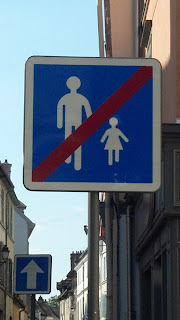finally found a magnet that will work, so I've got power meter data again. Please no comments on the pitifully small numbers.
Roughly the same distance as home in Boulder to work at University Hospital gets us from the capital of one country to the next, and indubitably from a Western European country to Eastern Europe with a history of Soviet style communism in the not too distant past.
Crossing the border, one gets to see the remnants of the border crossing, but it looks just like some old abandoned unusually shaped gas stations - otherwise, one would not notice a border. But, then you look around - especially after climbing the hill to the old castle - and having a good view - and there are lots of large, square, dull apartment buildings - unlike anything we've seen the last few weeks - but perhaps reminiscent of public housing from the eastern US (think Bed-Sty). The windowboxes of geraniums have disappeared. The paint is dull, and hasn't been renewed for a while.
The downtown area is a very nice pedestrian mall, lots of shops and outdoor cafes - more prominent English menus and signs, presumably related to a tourist clientele that is nearly all from out of the country. English is the primary language of tourism - more so than France or Germany - with an especially fluent young woman at the frozen yogurt stand.
But as soon as you leave the tourist center, it degenerates to a rather gray area very quickly.
We're staying in a "Botel" - an old river boat converted to a hotel, floating on the Danube - quite nice to look out the window and see the river and the river traffic.
Slovakia is about 1/5th the area of Colorado, roughly the same population as Colorado. Bratislava itself is a bit under 400,000 people. You can imagine how hard it would be to maintain (in the modern world) a language and way of life for Colorado if it was a separate country and language from the rest of the US. I find it interesting to try to wrap my head around comparable sizes of states in the US and countries in Europe.
Apparently Bratislava was about 40% Hungarian and 40% German, only 15% of its population Slovakian, up until World War I. After WW I, Bratislava became part of the new Checkoslovakia ( all had been part of Austro-Hungary prior to the war), and all the Hungarians got kicked out. After WW II, all the Germans got kicked out and now Bratislavia is 90% Slovakians. Quite a shift.
Tomorrow on to Hungary.










































